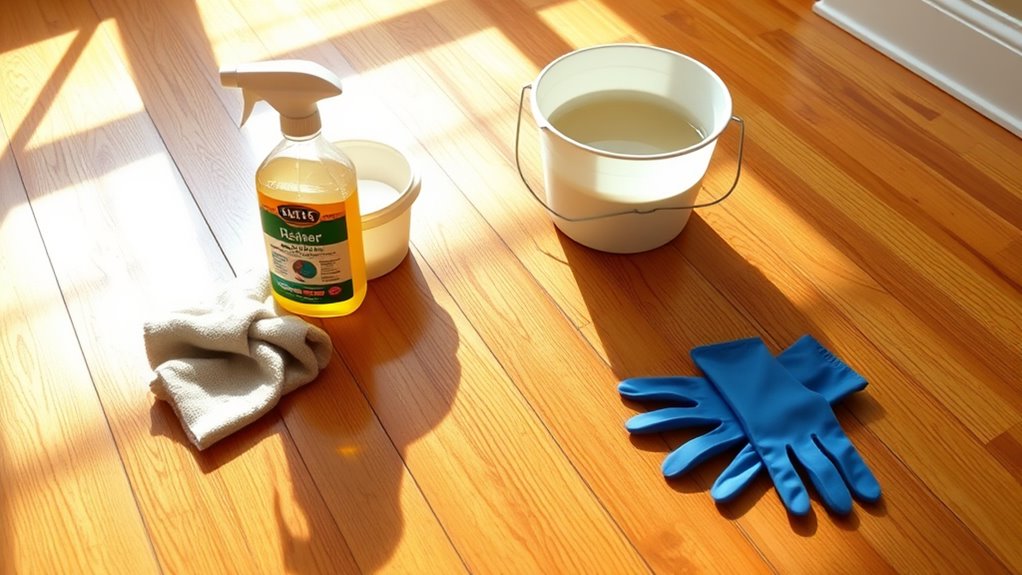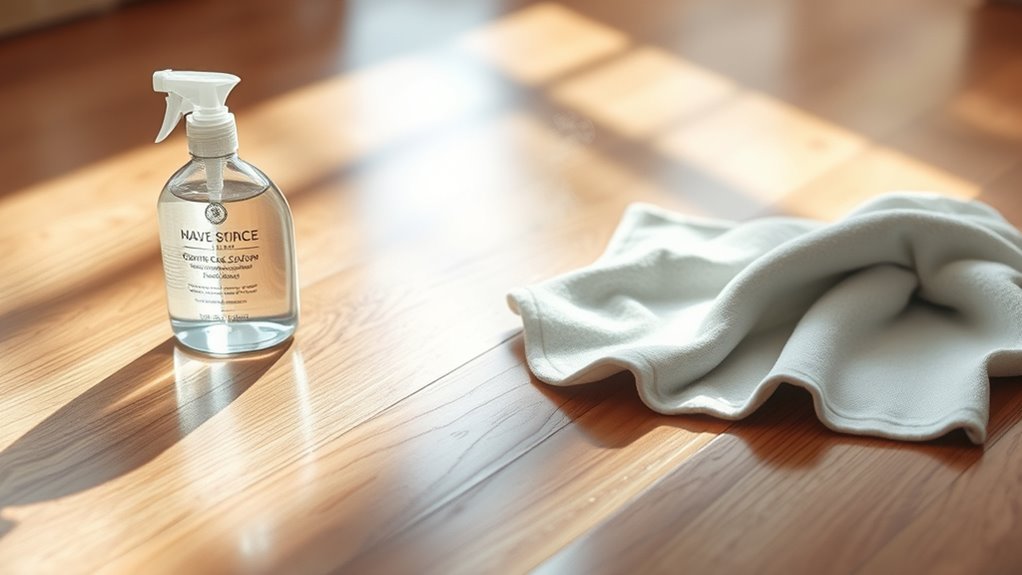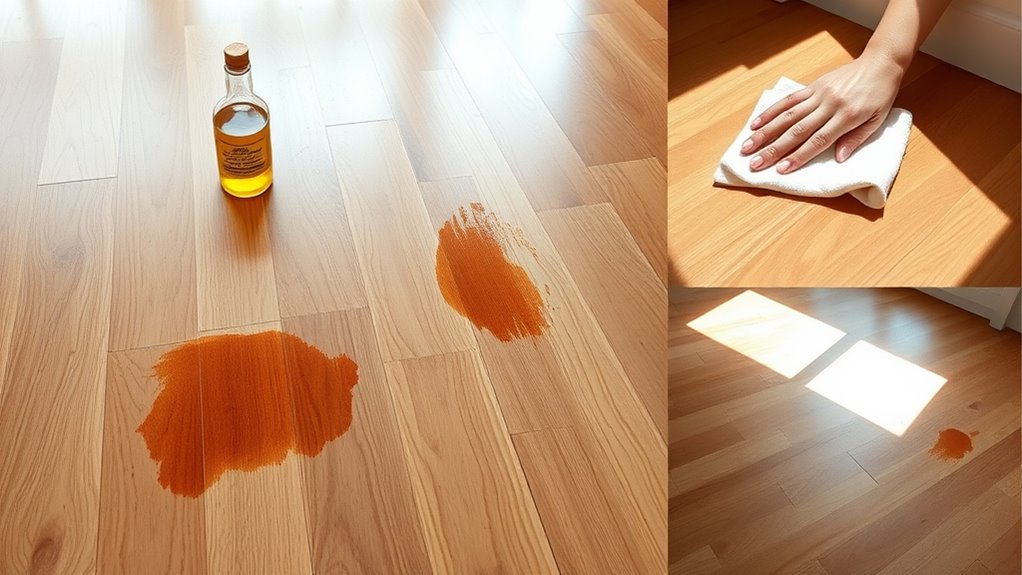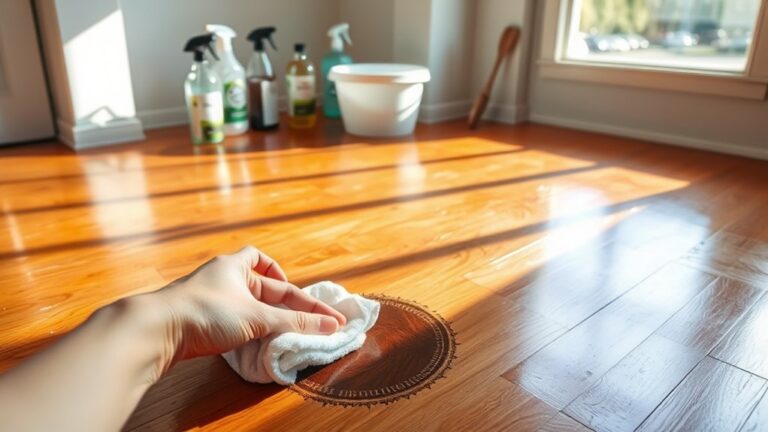To get stains off your hardwood floors, first identify the stain type—water, oil, ink, or pet stains—to choose the right cleaner. Gather soft cloths, mild soap, and pH-neutral cleaner. Clear and dust the area, then apply a gentle cleaning solution, avoiding harsh chemicals. Gently rub the stain with a soft cloth, rinse with a damp cloth without soaking, and dry thoroughly. Proper care prevents damage and keeps your Boden fresh. You can explore detailed methods for tougher stains and upkeep next.
Identify the Type of Stain on Your Hardwood Floor

How do you know which cleaning method to use? It all starts with stain identification. Different stain types—such as water rings, oil-based spills, ink, or pet stains—require specific treatments. First, observe the stain’s color, texture, and location. Water stains often appear as white or dark rings, while oil stains tend to be darker and greasy. Ink marks are usually sharp and defined. Pet stains might have a discoloration combined with an odor. By accurately identifying the stain type, you avoid using harsh chemicals that could damage your hardwood floors. Understanding these stain types gives you the freedom to select the safest, most effective cleaning method, ensuring your floors stay beautiful without unnecessary risk or effort.
Gather the Necessary Cleaning Supplies
Once you’ve identified the type of stain, you can gather the right cleaning supplies to tackle it effectively. Selecting appropriate cleaning supplies is essential for successful hardwood maintenance and stain removal without causing damage. Here’s what you’ll typically need:
Identify your stain type first, then gather the right supplies for effective, damage-free hardwood cleaning.
- Soft microfiber cloths or sponges – gentle on the wood surface.
- pH-neutral hardwood floor cleaner – guarantees effective cleaning without stripping finishes.
- Mild dish soap – useful for grease or sticky stains.
- Optional: fine steel wool or a specialized hardwood stain remover for tough marks.
Having these items ready empowers you to act quickly and maintain your floor’s natural beauty. Avoid harsh chemicals or abrasive tools that can harm the wood. With the right supplies, you’re set to proceed confidently toward restoring your hardwood floor’s pristine look.
Prepare the Hardwood Floor for Cleaning

Before you start removing stains, make certain to clear the floor of any furniture or rugs. Next, thoroughly dust and sweep to eliminate dirt that could scratch your hardwood during cleaning. Finally, select the right tools, like a soft cloth or mop, to guarantee effective and safe stain removal.
Clear the Floor
A clear floor is essential for effective stain removal on hardwood. Before you start, remove any items that could obstruct your work or cause new stains. Clearing the floor also allows you to assess the surface for damage or areas needing special attention. To prepare properly:
- Remove furniture and rugs carefully to avoid scratching.
- Store items safely to prevent dust accumulation and maintain floor protection.
- Check the floor’s finish to match stain removal methods without damage.
- Plan your cleaning frequency to keep stains manageable and floors looking fresh.
Dust and Sweep
With the floor cleared, dusting and sweeping come next to remove loose dirt and debris that could interfere with stain removal. Start by using effective dust removal techniques—opt for a microfiber dust mop or cloth to capture fine particles without scratching. Sweep thoroughly, focusing on corners and under furniture where dust accumulates. This step prevents grit from spreading or scratching the wood during deeper cleaning. Dust and sweep regularly to maintain your floor’s finish and make stain removal easier. Remember, proper dust removal sets the foundation for successful stain treatment, so don’t rush through it. Taking these cleaning techniques seriously guarantees your hardwood floor stays pristine and ready for the next steps in the stain removal process.
Choose Cleaning Tools
Two key tools you’ll need to prepare your hardwood floor for cleaning are a gentle scrub brush and a soft cloth. Selecting the right cleaning tools is essential for effective hardwood care and avoiding damage. Here’s what to focus on:
- Gentle scrub brush – soft bristles to lift stains without scratching.
- Microfiber cloth – absorbs moisture and lifts dirt delicately.
- Non-abrasive sponge – for spot cleaning stubborn marks.
- Dust mop or vacuum with hardwood attachment – to remove loose debris before wet cleaning.
Using these cleaning tools guarantees you protect your floor’s finish while tackling stains efficiently. Avoid harsh brushes or rough cloths that can wear down the wood. By choosing the right tools, you maintain your freedom to enjoy a clean, beautiful hardwood floor without damage or extra effort.
Apply a Gentle Cleaning Solution

Start by mixing a gentle cleaning solution that won’t damage your hardwood floors. Combine a few drops of natural cleaners like mild dish soap or white vinegar with warm water. These options are effective yet safe, preserving your floor’s finish while aiding stain prevention. Avoid harsh chemicals that can strip the wood or leave residues. Measure carefully: too much soap or vinegar can dull the surface, so balance is key. This simple blend respects your floors’ integrity and supports your freedom to maintain them without worry. Once mixed, test the solution in a small, hidden area to verify it won’t cause discoloration. This step guarantees you’re protecting your hardwood while preparing to tackle stains effectively and responsibly.
Use a Soft Cloth or Sponge to Remove the Stain
Gently rub the stain using a soft cloth or sponge dampened with your cleaning solution. This method guarantees effective stain removal while protecting your hardwood’s finish. Follow these steps for best results:
- Use a circular motion to lift the stain without spreading it.
- Avoid excessive pressure to prevent damaging the wood surface.
- Frequently rinse the cloth or sponge to remove lifted residue.
- Apply light, consistent strokes to break down the stain gradually.
These cleaning techniques not only remove stains but also contribute to stain prevention by avoiding harsh scrubbing. By choosing a gentle tool, you maintain the floor’s integrity, preserving its natural beauty and freedom from damage. This approach balances effective cleaning with care, guaranteeing your hardwood floors stay pristine longer.
Rinse and Dry the Treated Area Thoroughly
Once you’ve lifted the stain, you’ll want to rinse the area thoroughly to remove any leftover cleaning solution. Using effective rinse techniques is essential—grab a clean, damp microfiber cloth and gently wipe the spot to avoid leaving residue that can dull your hardwood’s finish. Avoid soaking the wood, as excess moisture can cause damage. After rinsing, focus on drying methods to guarantee no water remains. Use a dry, soft towel or cloth to absorb moisture quickly. You can also air-dry the area by allowing good ventilation but avoid direct sunlight that may warp the wood. By carefully rinsing and drying, you protect your floor’s integrity and keep it looking fresh and stain-free. This step guarantees your hardwood floor stays in top shape.
Prevent Future Stains and Maintain Your Hardwood Floors
After thoroughly rinsing and drying your hardwood floor, the next step is to focus on preventing future stains and maintaining its appearance. Effective stain prevention and consistent floor maintenance will keep your floors looking fresh and protect your investment.
Thorough rinsing and drying set the stage for lasting stain prevention and floor care.
- Use area rugs or mats in high-traffic zones to catch dirt and spills.
- Clean up spills immediately to avoid stains setting into the wood.
- Apply a protective finish or sealant annually to enhance stain resistance.
- Regularly dust and mop with a damp, well-wrung cloth to remove grit that can scratch surfaces.




